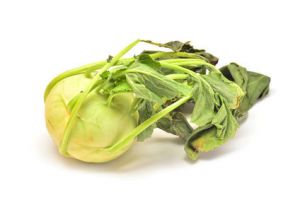
Kohlrabi is not very well known in the US, although it is prevalent in German and Eastern European cuisines. It is a member of the Brassica family, along with cabbage, brussels sprouts and kale. Kohlrabi is highly versatile to cook with and offers a number of health benefits.
In German, the word kohlrabi translates to ‘cabbage turnip,’ which aptly describes its appearance. The plant can be either purple or green, and consists of a spherical head with a long stem and sprouting leaves. The head of the kohlrabi tastes somewhat like a sweet, juicy variety of cabbage, and the leaves are reminiscent of kale – and can be prepared in much the same way.
One of the main benefits of kohlrabi is its high vitamin C content. One 4.7-ounce serving contains 140 percent of your daily value of this important vitamin. This trumps even the famous vitamin C-providing orange.
Vitamin C is essential for the health of the immune system, and improves the body’s ability to fend off and fight disease. Especially in the winter season, extra ammunition against those nasty colds and flus is essential. Vitamin C also helps the body regenerate vitamin E, and to absorb iron.
Kohlrabi is rich in fiber, which helps to maintain digestive health and feed healthy gut bacteria, and also aids in stabilizing blood sugar levels. It is also a good source of potassium, which, among a variety of other functions, helps the body properly store and use energy, and maintains optimal nervous system health.
The high fiber content of kohlrabi joins forces with its omega-3 fatty acids to keep your heart healthy. Omega-3’s have been linked to having significant benefits for various cardiovascular functions, and may help prevent the risk of heart disease.
The variety of anti-inflammatory antioxidants and phytochemicals found in kohlrabi also help to shield you from chronic diseases, including heart disease and cancers.
On top of that, kohlrabi contains calcium, magnesium and phosphorus, which combined make it a great veggie for supporting bone health. This nutrition-packed veggie also has vitamins B1 and B6, folate, and the minerals copper and manganese.
 Kohlrabi can be prepared or cooked in a multitude of ways. In its raw state, it is wonderful in salads, and is even eaten raw and whole in Poland. Just make sure you peel the head, and the rest is entirely edible. It can also be used in a stir fry, steamed and mashed, added to stews, grilled … and the list goes on. One North Indian recipe consists of using both the head and leaves of the kohlrabi in a spicy gravy.
Kohlrabi can be prepared or cooked in a multitude of ways. In its raw state, it is wonderful in salads, and is even eaten raw and whole in Poland. Just make sure you peel the head, and the rest is entirely edible. It can also be used in a stir fry, steamed and mashed, added to stews, grilled … and the list goes on. One North Indian recipe consists of using both the head and leaves of the kohlrabi in a spicy gravy.
Although you might have to search further than your grocery store produce aisle to find it, kohlrabi is one veggie definitely worth getting to know.
-The Alternative Daily
Sources:
http://nutritiondata.self.com/facts/vegetables-and-vegetable-products/2466/2
http://www.theguardian.com/lifeandstyle/2013/jul/06/good-for-you-kohlrabi
http://www.3fatchicks.com/5-health-benefits-of-kohlrabi
http://www.jrorganicsfarm.com/blog/tips/kohlrabi-tips-information

